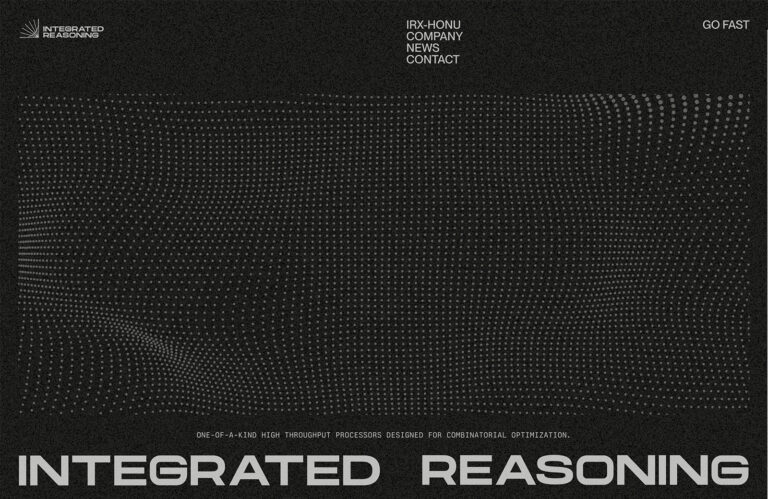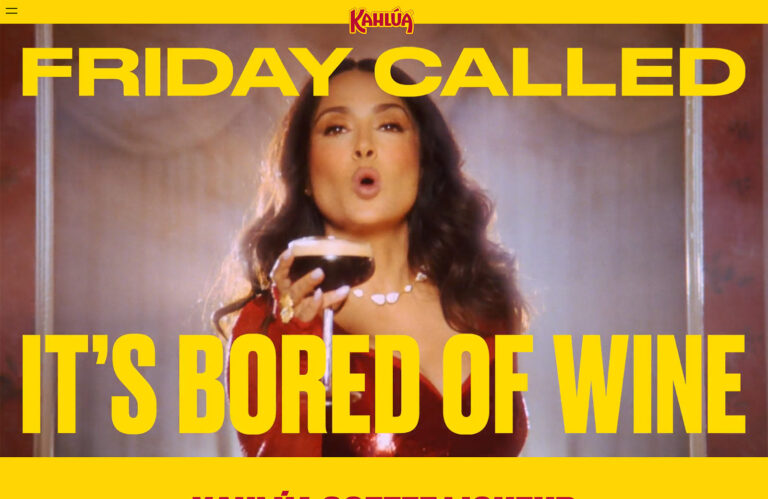
February 21, 2024
Mind-bending videos. Divisive Images. Eye-straining visuals. This list of optical illusions has it all. Join us as we melt our brains with 20 of the greatest optical illusions of all time.

Optical illusions take many different forms. From floating ships and misaligned triangles to non-existent shapes and still images that move, it feels like there are millions of different ways to trick our brains into seeing the impossible.
In this article, we’ve picked out twenty of our all-time favorite illusions. We’ll cover the certified classics, showing that incredible illusions never go out of fashion. We’ll also dive into the mind-boggling 2023 Illusion of the Year winner, proving that there’s no shortage of inventive ways to blow our minds.
We won’t keep you waiting in anticipation any longer. Let’s get into the list.
1) An unusual grid
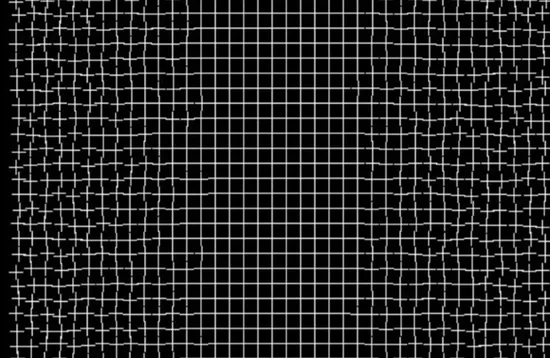
Ah, the uneven grid—a data analyst’s worst nightmare. If you’re a lover of uniformity, you’ll surely detest the irregularity of these lines. But what if our brain could fix the problem? Well, it turns out it can.
Focus on the center of this grid for twenty seconds, and the disjointed lines at the edge of the illusion will begin to fix themselves. As if by magic, your brain will begin to process a completely uniform image. Neat, huh?
Supposedly, this is due to the brain’s bias toward ordered patterns. The mind simply sees what it wants to see.
While the grid returns to its usual disjointed self the moment you reset your vision, at least we can all have some temporary relief. Graph makers and statisticians rejoice.
2) This one hurts the eyes a little bit.
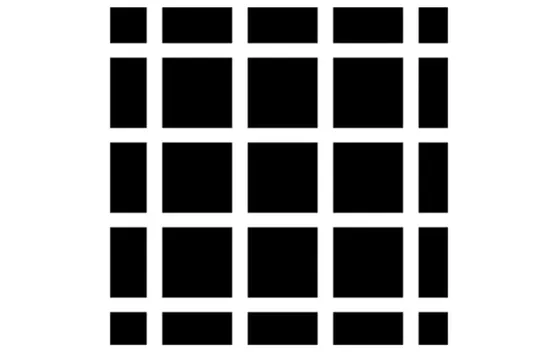
No list of mind-boggling optical illusions would be complete without a certified classic. This is one of our favorites because it works instantly with no lengthy periods of staring required.
As you look at the image, you’ll likely see a range of gray-black dots where the white lines meet. But there aren’t any.
This is a prime example of the scintillating grid illusion, in which our eyes perceive ghostly dots that aren’t actually there. Want to make the spots disappear? Just focus on one of the intersections between the squares.
3) Harry Potter and the Sorcerer’s Illusion
Remember that scene in the first Harry Potter movie when all of the students run through the brick wall only to arrive at Platform 9 and ¾? While this illusion doesn’t quite live up to the magic of Hogwarts, it certainly comes close.
At first, it seems as though the car in this video passes directly through a brick wall. If you’re skeptical like we are, you likely immediately assumed this was some form of editing.
But keep watching, and you’ll quickly realize how the trick works. In short, the wall has a carefully placed hole in it, just large enough to allow the car to pass through without a hitch.
Matt Pritchard, the creator of this anamorphic illusion, used shadows from strategically placed lights to design a paper cutout that aligns seamlessly with the bricks in the wall (when viewed at the right angle, of course).
This one is genius, and the justified winner of the 2023 Illusion of the Year contest.
4) Not this again – do you see a rabbit or raven?
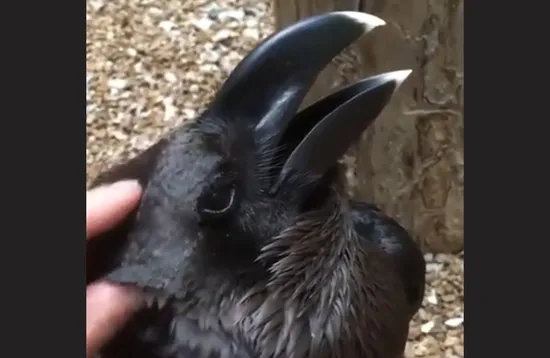
Sometimes, the best illusions are the ones that happen unintentionally. Did we hear Yanny or Laurel? Was the dress blue and black or white and gold? Does the image above show a bunny having its nose stroked or a raven getting a head massage?
Depending on which way you view this image, you may either see a bird or a bunny. The original post revealed that this was a rabbit having its nose stroke, but we think that was just to throw us off. After all, it’s a bird, isn’t it? Please tell us it’s a bird.
Incidentally, this image feels startlingly similar to the iconic 19th-century duck or rabbit illusion.
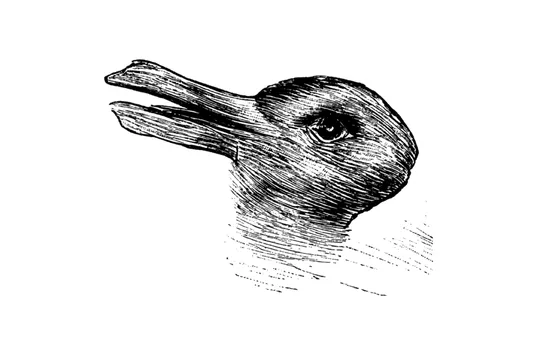
If this tells us anything, it’s that people have been seeing the unusual similarities between birds and bunnies for a lot longer than we thought.
5) The Kanizsa Triangle – Can You See It?
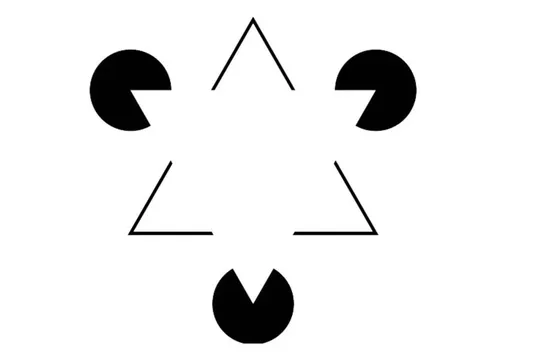
If there’s any illusion that tells us how much our brain craves order, this is the one.
When staring at this image, you’ll likely see a white triangle in the center. Trouble is, that triangle doesn’t exist.
The strange illusion occurs because our brain automatically fills in the gaps created by the other shapes in the image.
In the case of the Kanizsa triangle, our brain automatically ignores the gaps, allowing us to see the triangle as if it were actually there. Spooky.
6) An Animated GIF… Wait.
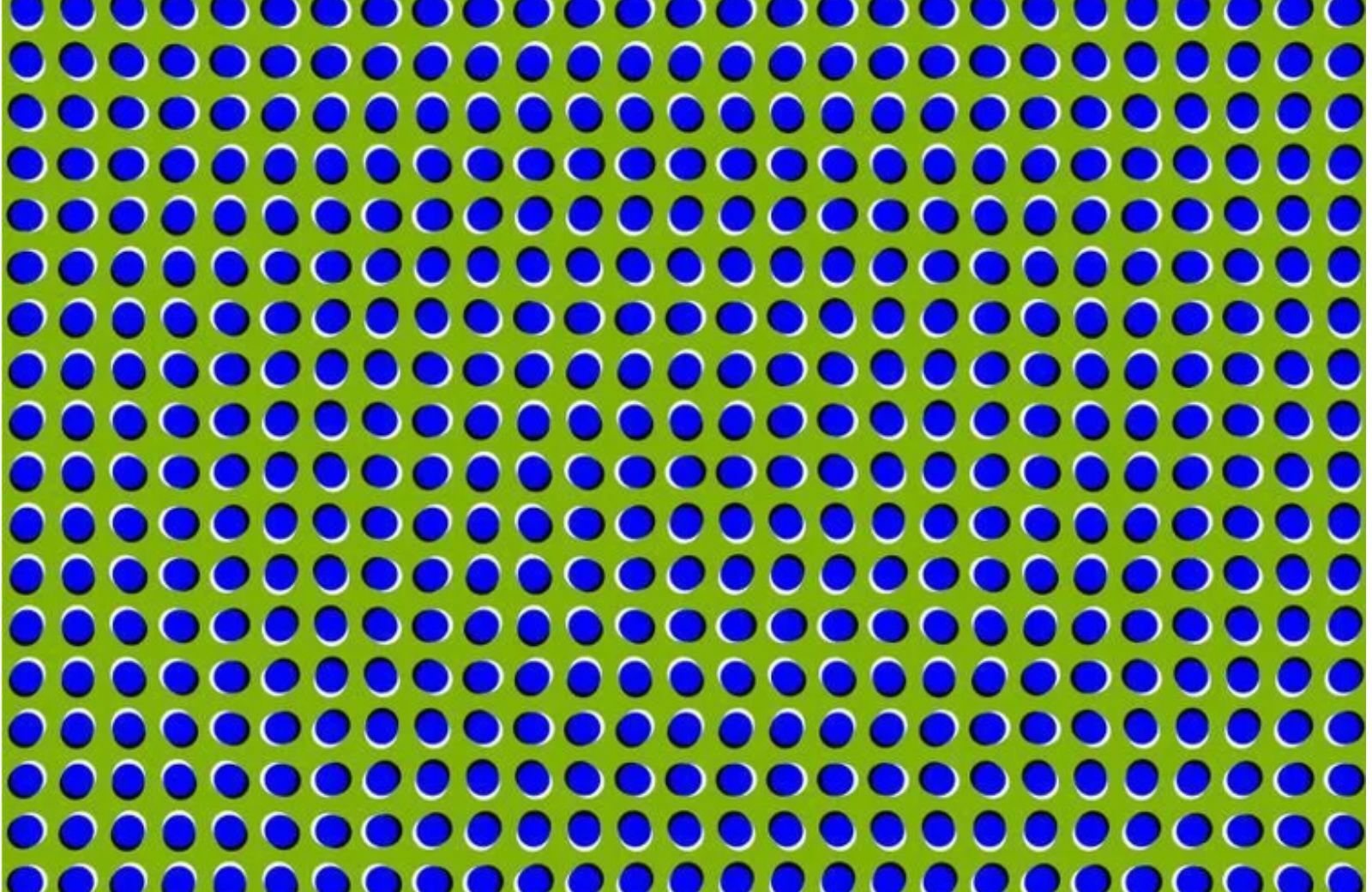
At first glance, you may believe we’ve snuck in a GIF to trick you. But think again. This image is actually static.
If you stare at one point on this dotted grid, the image stops ‘moving’. As soon as your eyes drift around the screen, however, the circles distort and warp, giving the impression that they’re in motion.
This is a classic example of a peripheral drift illusion. The movement occurs because the brain takes time to process the different lights, colors, and shapes on the screen. This slight lag makes our brain believe the image is moving, even when it isn’t. Mind blown.
7) The Ponzo Illusion – Which line is bigger?
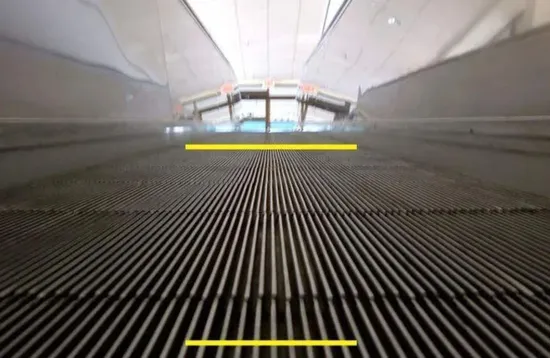
When you look at this picture, which line is bigger?
What if we told you that both are exactly the same size?
This is a classic example of a Ponzo illusion, wherein the brain uses the context of a background to judge the size of an object automatically.
In short, our brains are great at judging perspective. So great, in fact, that they trick themselves into believing that the higher object is farther away and, therefore, larger than the ‘nearer’ object.
Of course, this trick doesn’t just apply to low-resolution photos of escalators. Here’s a simplified drawing that illustrates why the illusion is so effective.
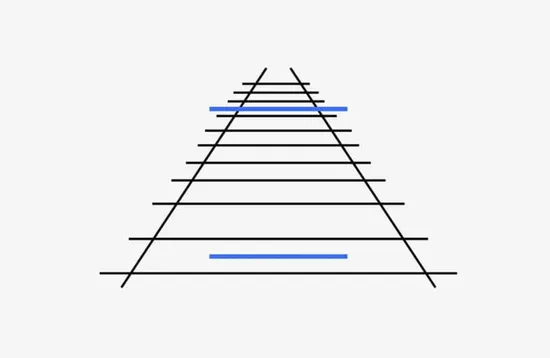
8) The Ebbinghaus Illusion – Which circle is bigger?
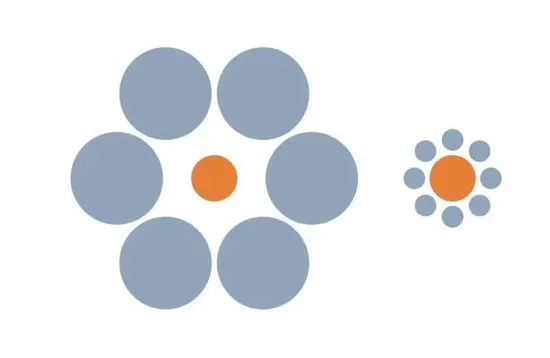
If you’ve reached this point in our article, we likely don’t need to tell you what the catch is here.
That’s right. You guessed it. Both circles are exactly the same size.
The theory here is that we believe the circle on the right is bigger because of the comparably large size of the gray circles surrounding it. This makes the orange circle on the left look smaller, despite the fact it’s actually the same size.
9) The Poggendorff Triangles
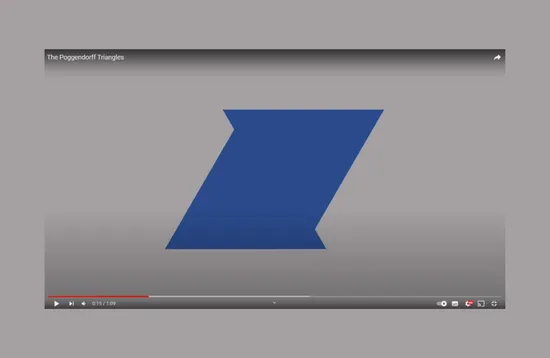
When you look at this image, what do you see?
Chances are, you see two triangles side by side. Your brain probably also believes that the two triangles share a ‘common border’, so much so that you could draw a natural line intersecting the shapes to better define the two equilateral triangles.
So, where’s the illusion? If you haven’t already guessed, these triangles don’t actually intersect. In fact, if you were to ‘complete’ the two shapes, it would actually look something like this.
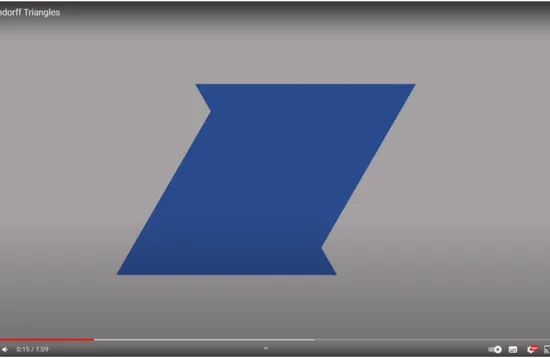
The triangles don’t line up, so why does our brain convince us they do? In short, it comes down to the way our brain misunderstands partially occluded objects. We call it the Poggendorf illusion, and it’s as intriguing as it is mind-bending.
10) Are they really spinning?
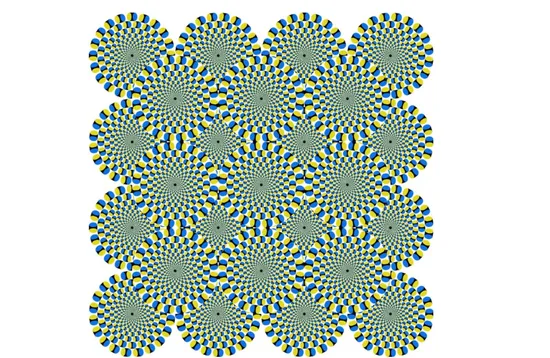
Trust us, this isn’t a GIF. It’s another static image that makes you feel as though you’re watching a video. The wheels on the screen appear to turn before your eyes, but they aren’t actually moving at all.
This spinning wheel illusion, made famous in Clive Gifford’s Eye Benders book, occurs because our eyes are constantly refocusing to account for different perspectives, light intensities, and colors.
Much like the green and blue dots from earlier, the lag from our brains creates the illusion of movement. You can put this one to bed by focusing on a single point in the image.
11) What lurks beneath?

At first glance, this appears to be a picture of simple vertical stripes. But there’s something else hidden under the surface.
To see this illusion in full effect, shake your head from side to side. Try not to make yourself cross-eyed in the process.
Eventually, you’ll start to see the image of a cat surface from beneath the stripes. Don’t believe us? Try it for yourself!
12) Two different shades of gray?

What could possibly be so interesting about a black-and-white image of a house, you ask?
If you’re familiar with optical illusions, you may already know the catch here. Each of the red arrows points to a stone in the wall—one stone is light colored; the other is dark. But is that really the case?
No. Both stones are actually the same color.
This image comes from the Massachusetts Institute of Technology’s study on an illusion called simultaneous brightness contrast. In short, the relative brightness of the picture around the two stones impacts how dark or light we perceive the bricks to be.
For a more straightforward example of this trick in action, here’s an image of two identical-colored circles on different backgrounds.
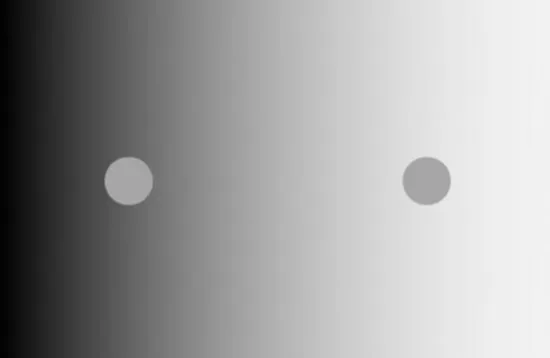
Our brains perceive the one on the left to be lighter even though both are the same shade of gray. Mind-boggling stuff.
13) The Phantom Queen
This one won the Illusion of the Year back in 2021, and for good reason. The video depicts an invisible queen moving across a chess board reflected back to us by a mirror.
Initially, you may be thinking this is some clever CGI trickery, but think again. As the video reveals, the illusion actually relies on an intelligently designed anamorphic perspective illusion.
How does it work? A red and gray piece of paper blends seamlessly with the board, blocking the reflection of the queen from our view. Of course, it only works at one angle, but that doesn’t make it less impressive.
This is one of those illusions you really have to see for yourself to believe. Give the video a watch and prepare to have your mind blown.
14) Is the cat going up or down?
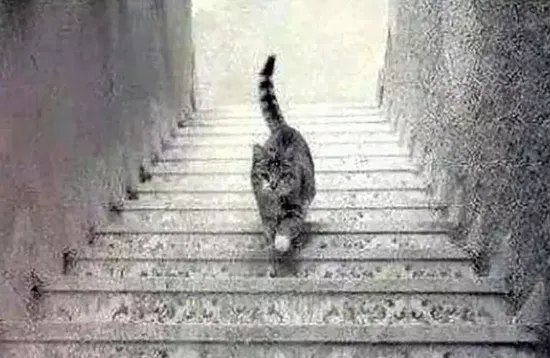
Now, for something a little more subjective. Is this cat traveling up or down the stairs?
If you said it’s heading down the stairs, that puts you on par with around half of the population. If you said up, you’re right on track with the other half.
According to some reports, those who think the cat is moving downward are pessimists, whereas the ones who believe the cat is traveling upstairs are optimists.
We’ll leave the hard-to-prove psychological theories to the experts. For now, let’s all just enjoy this incredibly divisive illusion.
15) The Flying Dutchman

We always hold a special place in our hearts for optical illusions that occur naturally in the world.
Take this floating ship, for instance. This is a textbook example of Fata Morgana, a naturally occurring illusion where layers of hot and cold air distort our view of the horizon.
As this illusion requires vast distances to come into effect, we most commonly view Fata Morgana at sea. In this case, the illusion makes this boat look like it’s floating in mid-air.
You can really see how myths such as The Flying Dutchman came into existence. If any of us saw this before a valid scientific explanation existed, we’d likely think the end of the world was nigh. Scary stuff.
16) Why are our brains like this?
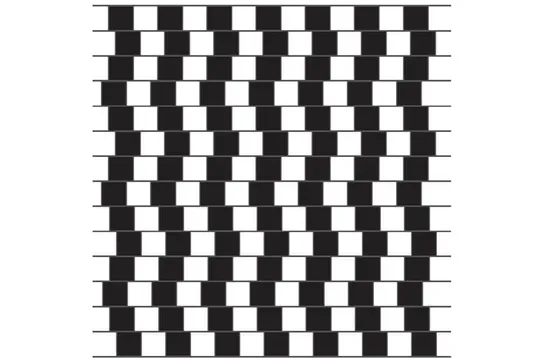
These lines appear to be sloping up and down. The illusion? You guessed it. They’re actually straight.
This is the cafe wall illusion, in which parallel lines between staggered rows of dark and light squares appear to be sloped. Why, you ask? Apparently, it’s because our brain perceives white shapes to be larger than black ones. Because science!
If you’re looking for definitive proof that this is, in fact, an illusion, try isolating one stripe with some sheets of paper. Slanted lines, begone.
17) Yet another GIF, right?
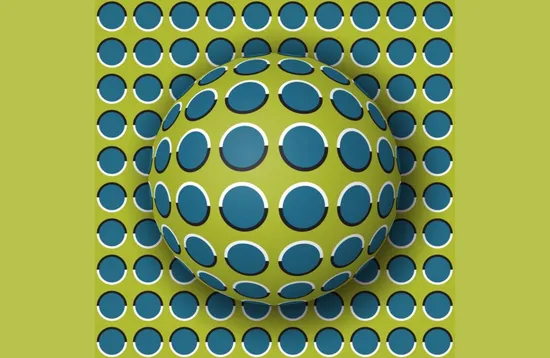
It looks like the background underneath this multi-colored sphere is slowly moving downward. But, as with all iconic peripheral drift images, what you’re seeing is nothing but an illusion.
Our brains simply can’t keep up with what our eyes are seeing. Clearly, evolution wasn’t ready for the invention of internet optical illusions.
18) The illusion of perspective
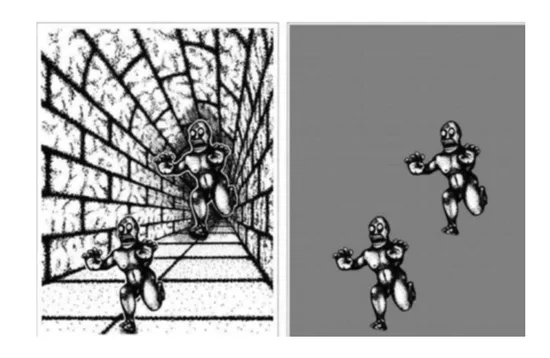
Which of these monsters is bigger? The one at the back, right? Wrong again, visual cortex. They’re both the same size.
This one works in a very similar way to the Ponzo illusion we included at number 7. Our brains use context to view images all the time. Therefore, when we view the monsters in the tunnel, we immediately assume the fellow at the back is larger. Weird, right?
19) The illusion of perspective

Okay. Of all of the illusions on this list, this is the one that we simply can’t unsee. The pears are clearly different colors. The one on the left looks dark green. The right? Aqua at best.
You know where we’re going with this by now.
insert
That’s right. Both pears are exactly the same color. Mind-bending stuff. Like the image of the black-and-white house, this is another impressive example of simultaneous brightness contrast.
20) Squares or circles?

If you’re staring at this image and see ornately decorated black and white rectangles, you’re not alone. But look again.
These ‘squares’ are actually the result of floating circles perpendicular to a striped background. The positioning of the circles makes it appear as though you’re staring at picture frames or panels on a coffer.
Oddly enough, this is an illusion that we can seemingly ‘switch’ on-and-off at will. Every time we stare at it, we either see circles or squares. It all depends on what our brains want to see.
Our brains need a rest…
If this list has taught us anything, it’s that our eyes and brains don’t always work the way we want them to.
If you’d like to give your brain a break, why not view our countdown of the 30 best new fonts of 2023? We promise it’ll be a little easier on the eyes than this mind-boggling list.
Has your mind been blown? Got a crazy optical illusion you’d like to share? Tweet at us and let us know.
Max Walton
Born in Cardiff Wales, Max relocated to Brisbane when he was 12. He’s spent the last five years developing expertise in the Fintech industry. When he’s not posting about Web3, you’ll find him on a paddleboard.
